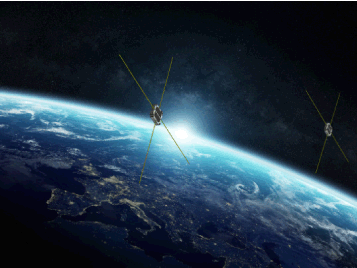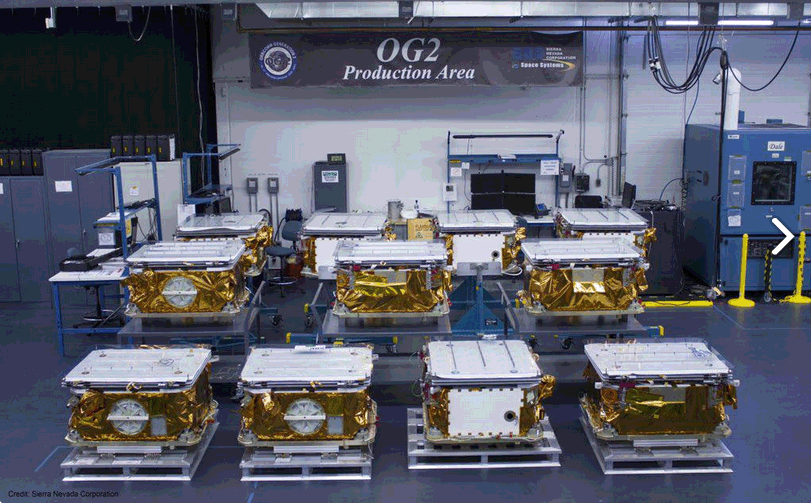Update on the Satellite Internet of Things Market
by Hub Urlings and Marco Franken
Amsterdam, the Netherlands, March 4, 2022--These are exciting times for those following the 25-year-old satellite IoT market developments. Currently, we see more than 40 Sat-IoT networks (according to Berg Insight 2021) that are commercially available in the market or on the verge of being launched, and the number of new announcements of satellite IoT constellations is still growing.
Everybody is now waiting for the new networks to fulfil their promise of low-cost global connectivity. So let's have a look at where we stand.
Satellite IoT incumbents of the first-generation like Argos (since 1978) and Inmarsat-C (since 1999), later joined by Iridium, Globalstar, and Orbcomm (second-generation), have ruled the market for decades. However, triggered by the strong growth of the Internet of Things and the new small-sat technology from 2015 onwards, we have seen the emergence of the third-generation satellite IoT networks, also referred to as the Low Power Global Area Network (LPGAN). In a reaction to that and from 2018 onwards, we also see a fourth-generation trying to complement terrestrial IoT networks using similar communication protocols like LoraWan, NB-IoT, or even Wifi,
Is this a flight forward? Do we stay raising funds for developing new satellite IoT networks with yet a better technology, reducing connectivity costs? What about the promises of the LPGAN systems? Are they becoming a reality?
Time to put things in perspective, reflect for a moment, and look forward to the situation at the satellite IoT supply side in 2022, with a focus on the third-generation LPGAN systems. We do this based on our research for the Satellite IoT Monitor 2022 and the results of the Satellite IoT Test bench we operate to monitor the reliability and latency of the new networks. But let’s start with a quick look at the history of satellite IoT.
A short history of satellite IoT
Some 25 years ago, Inmarsat launched the first generation of satellite IoT systems using their geostationary satellites and L-band with Inmarsat-C. Although initially designed for the maritime market, Inmarsat-C started in the government market; its high reliability matched the need for reliable communications for remotely operating units. In particular, they were providing critical communication to peacekeeping troops in Yugoslavia, such as trucks for food distribution.
Quickly after that, the maritime market picked up the service, mainly because Inmarsat-C equipment was the most cost-effective way to comply with the Global Distress and Safety System (GMDSS) requirements, which applies to every ocean-going vessel. Not long after that, the long-haul trucking market discovered the service to track their fleet of trucks and cargo. The service also serviced utility networks monitoring oil pipelines, electricity grids, and mining equipment in the energy sector.
The success of Inmarsat-C attracted competition. What if we go from Geo to Leo? A couple of years later, the second generation of satellite IoT operators launched their LEO constellations, including Iridium, Orbcomm and Globalstar.
In the first decades of the 21st century, the satellite IoT market became an oligopoly with a limited choice for customers. Moreover, the oligopoly translated into relatively high prices and engineering costs. As a result, the market focus remained on niche markets for critical communications that only very slowly grew up to circa 4.5 million satellite IoT terminals in the field today.
Until 2015, third-generation satellite IoT networks started challenging the incumbents, driven by the strong growth of IoT in general and the technological advances in small satellite manufacturing. The new breed of satellite entrepreneurs financing Low Power Global Area Networks (LPGAN) companies like Fleet Technologies and Myriota from Australia, Kepler Communications and Swarm from North America, and Lacuna, Hiber, Kineis, and Astrocast from Europe allowed the building of their first individual pathfinder small-sats. They launched them with traditional launchers like PSLV in India or Soyuz in Russia. Still, newcomer SpaceX quickly took a large share of the launcher market offering ride-shares - sometimes launching 100 small satellites in one go.
Developments do not stop with the third-generation satellite IoT networks. In 2017-2018 a fourth-generation of satellite IoT networks was initiated that used existing satellites to offer satellite IoT connectivity. We see Echostar Mobile, HiSky, and e-Sat Global using existing Geo satellites for their next-generation IoT platforms.
Other network operators decided to use existing terrestrial protocols for their IoT connectivity. Think of Lacuna, ELO (Eutelsat) or Satelliot, and Fossa Systems (Spain), or the recently launched Dewasat (UAE); all are relying on the existing LoraWan protocol to communicate with Low Earth Orbit satellites. With the recent release of a new Lora chipset by Semtech, this network shows strong growth and interest. The prospect of complementing the Lora-based terrestrial Low Power Wide Area Networks (LPWAN) with low-cost satellite connectivity, establishing a Low Power Global Area Network (LPGAN), is very appealing.
A third group in the fourth generation is using terrestrial cellular protocols. The fourth-generation includes Luxembourg-based QO, the Spanish Sateliot and Fossa, US-based Omnispace, Lynk Global, and AST Space Mobile.
The central philosophy of the fourth-generation satellite IoT deployments, complementing the coverage of terrestrial networks with (practically) the same equipment both on land and in space, makes sense. Moreover, experience suggests that this approach can reduce equipment costs while leveraging the existing cellular operators, service providers, and reseller networks as a distribution channel with limited training and education.
However, the fourth-generation development is still on an early technology readiness level, with some first pathfinder satellites in space. It will take some time to evolve from this to the necessary competence for commercial service.
The question is also whether technology is the single most decisive factor here. The regulatory environment, both on an ITU and national level, for using terrestrial frequencies for ground-to-satellite connectivity used by these systems might be the more significant challenge.
Launching the LPGAN Generation in 2022
The basis for this article was research on the satellite IoT supply-side conducted by M2sat IoT Lab since May 2020 formed the basis for this article. At first, the recently updated Satellite IoT Monitor 2022 assessed nine third-generation satellite IoT networks, the so-called Low Power Global Area Networks. Secondly, we use the results of the Satellite IoT testbench we run in our lab, including 15 modems from 6 different first and second-generation networks. The testbench monitors service quality mainly in terms of latency and reliability.
Combined, these two lines of research provide us with an accurate status of the different satellite IoT networks, their terminal equipment, and the service quality of the offered IoT connectivity. Based on that, we made the following conclusions.
More than six years after their foundation, the third generation satellite IoT is only beginning its commercial phase. However, the main interest from satellite service providers or customers is with satellite IoT services that do more than work from a technical perspective. A commercial service extends beyond moving bits over satellite and includes a distributor, service providers, and system integrator network. In addition, it has the appropriate landing rights to be operated from countries worldwide.
Out of the ten satellite IoT third-generation networks in early 2022, a small number seem to be progressing well and have already been announced commercially available on the market (Myriota, Head, Swarm). Others are close behind and on the verge of launching their commercial service (Astrocast, Kepler).
Swarm Technologies has around 120 satellites already in space, a remarkable achievement in such a short time. Their equipment is low cost, easy to install, and their service has an attractive price. It will be interesting to watch the quality of service (QoS), especially when satellite IoT
 |
| Swarm, with around 120 satellites already in space, is disrupting the satellite communications industry with affordable, easy-to-use products. |
Swarm Technologies has around 120 satellites already in space, a remarkable achievement in such a short time. Their equipment is low cost, easy to install, and their service has an attractive price. It will be interesting to watch the quality of service (QoS), especially when satellite IoTdevice numbers grow significantly and they start transmitting their data messages simultaneously to a fixed number of satellites. Also, the regulatory framework is an important challenge for global deployment, but their US license should provide a good starting point for Swarm technologies.
Astrocast end of 2021, raised the funding to build out their network and has just launched their low-cost Astronode+ equipment. With satellites in space, Astrocast will start providing commercial services available in the same regions as the Thuraya satellites: Europe, Africa, the Middle East, and Asia, which is a considerable part of the inhabited world with many remote connectivity challenges.
The Myriota network is becoming more mature, with seven satellites launched with Rocket Lab in March 2021. In space, the new small-sats delivered an improved Myriota Network that was open to customers in the US and Canada for the first time.
An exciting satellite IoT innovation is the Myriota Mouse. The unit combines ingress protection (IP-65) and accelerated weathering (ASTM-G154) standards and easy integration with sensors, making life easier for system integrators and Sat-IoT service providers.
Before 2021, Fleet Space announced its new product strategy: the new Alpha constellation. Alpha satellites are created entirely through 3D printing. With the integration of Fleet’s beamforming and antenna technology and the next generation of Digital Signal Processing, the Alpha constellation sounds promising. However, the development, launch, and final deployment might take a couple of years before Fleet is ready for a commercial launch.
With 15 satellites in space, in 2021, Kepler Communications became Canada’s largest satellite operator (in terms of the number of concurrent satellites operationally in space today). After successfully introducing their Store and Forward service for large files (particularly in high northern and polar regions), Kepler introduces their satellite IoT services. For that, they are planning to launch up to 140 satellites. In addition, a recent financial injection will increase Kepler's satellite building capabilities (now up to 10 per month) and strengthen their team to manage this more complex operational environment.
Lost in space
Even in the world of Satellite IoT, is it not just sunshine with rocket launches shooting up satellites and successful funding rounds. Last year, we saw some Sat-IoT initiatives being shut down or disappear. Even though many current players are making good progress, several might never make it to the launch or commercial service. In the last quarter of 2021, Hiber announced they stopped developing their LEO constellation.
Also, the Indian-based Skylo using the Inmarsat Geo satellite for its services disappeared from the playing field. It also looks like we are witnessing the first signs of consolidation. How long will Swarm be on the market after being bought by SpaceX?
Are we ready for a new era in satellite IoT?
With the promise of ubiquitous global IoT connectivity with lower-cost services and devices with low power consumption, the LPGAN generation of satellite IoT networks has set very high expectations.
Not all systems will make it to the complete commercial phase, but some third-generation will do so, with some already offering their services and more expected to follow in 2022. (Oops! Did we not say that in 2021 as well?)
With the third generation fulfilling their promises to disrupt the satellite IoT market, low-cost global IoT connectivity will expand from the current niche markets in government, maritime, logistics, and energy utility grids to the broader market for non-critical applications.
 |
| Orbcomm's G2 satellites provide a wide range of machine-to-machine M2M communication services for all branches of industry and government, providing relay of small data packets at low latencies from mobile transmitters to ground-based terminals. |
It will happen a bit later than promised, maybe, but then again, looking back at the growth of the satellite IoT market over the past 25 years, we see Satellite IoT is a marathon that might well stretch over the next decade, not a sprint. Even when using so-called “low costs, easy to build small satellites.” The real challenge lies with establishing the global commercial and regulatory infrastructure required to expand to other markets.
The big question is how incumbent satellite IoT operators will react to the new generations of satellite IoT networks. Iridium, Inmarsat, Globalstar, and Orbcomm so far seem confident. Iridium has a brand new constellation in space to work with, while Globalstar is in the process of putting a new generation of satellites up there. However, their most essential assets are on earth, as incumbents have spent decades building an extensive global distribution network and a regulatory framework that allows them to sell their connectivity services worldwide. So how will they react in a market that goes from oligopoly into a situation of heavy competition?
Meanwhile, the IoT market has not waited for satellite operators to bring connectivity. After all, IoT is not about connectivity alone. Developments in sensor technology, data analytics, edge, and cloud computing are not waiting for new satellite networks to launch. Increasingly, they are offering innovative applications that minimise the data volume to be transmitted and power consumption as much as possible, regardless of the network they are using for their connectivity. Using state of the art IoT technology components could offer more advantages than just another cheaper connection.
Looking forward to the coming years with the third generation Satellite IoT Networks, equipment and connectivity costs for satellite IoT connectivity will go down significantly and become available for new customers and market segments from whatever location on our planet. And then, we did not even consider the 4th generation networks looking for hybrid solutions combining terrestrial (Wifi, gsm, Lora) and satellite networks to bring connectivity costs even lower and could be offered via existing distribution networks.
Choosing the correct network (out of 40 alternatives) for your global applications is challenging and depends on technical, commercial and regulatory factors. Therefore, it is essential to have a good overview of the different satellite IoT service options and insight into their networks' future proof.
The good news is that the growth of the (terrestrial) IoT market will remain a formidable driver for the development of satellite IoT. In a future article, we will have a closer look at what applications and customers will benefit from the satellite IoT.
---------------------------------------
 Hub Urlings was one of the pioneers of Satellite M2M as Product Manager Inmarsat-C at the famous KPN Station 12. The reliability and success of this “small data” satellite service, its global coverage and reliability made that the service was used for a myriad of applications.Now, 25 years later, he is again involved in the development of a new generation of Sat-IoT services working as Innovation Manager for the ESA program at Hiber. His company, M2sat, is a value added service provider for Sat-IoT services. He can be contacted at: urlings@m2sat.com
Hub Urlings was one of the pioneers of Satellite M2M as Product Manager Inmarsat-C at the famous KPN Station 12. The reliability and success of this “small data” satellite service, its global coverage and reliability made that the service was used for a myriad of applications.Now, 25 years later, he is again involved in the development of a new generation of Sat-IoT services working as Innovation Manager for the ESA program at Hiber. His company, M2sat, is a value added service provider for Sat-IoT services. He can be contacted at: urlings@m2sat.com
 Marco Franken has worked at Philips developing early-stage APIs for aero and government networks, followed by service and applications development at Inmarsat. In 2001 he managed the introduction of GPRS data services in Germany and the UK and developed multi-channel platforms for extreme environments. From 2006 he worked with Sybase and SAP to provide global availability of data messaging. His focus has been on efficient sensors, IoT, and intelligent data across insurance, finance, farming, and maritime. He can be contacted at: franken@m2sat.com
Marco Franken has worked at Philips developing early-stage APIs for aero and government networks, followed by service and applications development at Inmarsat. In 2001 he managed the introduction of GPRS data services in Germany and the UK and developed multi-channel platforms for extreme environments. From 2006 he worked with Sybase and SAP to provide global availability of data messaging. His focus has been on efficient sensors, IoT, and intelligent data across insurance, finance, farming, and maritime. He can be contacted at: franken@m2sat.com





